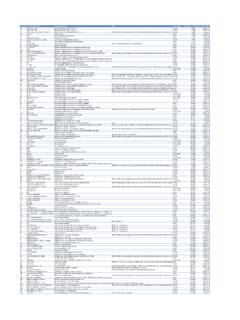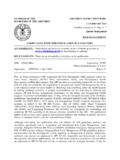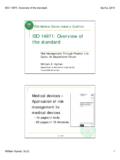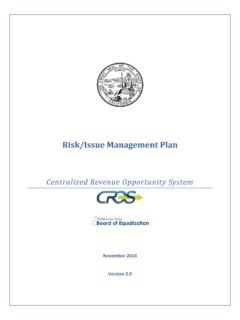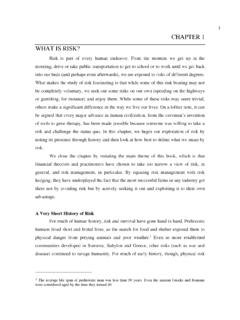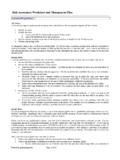Transcription of CDC UNIFIED PROCESS PRACTICES GUIDE
1 CDC UNIFIED PROCESS PRACTICES GUIDE RISK management UP Version: 11/30/06 Page 1 of 7 Document Purpose The purpose of this document is to provide guidance on the practice of Risk management and to describe the practice overview, requirements, best PRACTICES , activities, and key terms related to these requirements. In addition, templates relevant to this practice are provided at the end of this GUIDE . Practice Overview Project risk must be identified, managed, and addressed throughout the project in order for the project to be successful. Risk management plays an important role in maintaining project stability and efficiency throughout the project life cycle. It proactively addresses potential obstacles that may arise and hinder project success and/or block the project team from achieving its goals. Project risk can be anything that threatens or limits the goals, objectives, or deliverables of a project.
2 Project risk is present in all projects and may have one or more causes and, if it occurs, one or more impacts. RISK VS. ISSUES There is often confusion between Risk management and Issue management and how the activities of each interface and interact with each other. According to the Project management Institute (PMI) Project management Body of Knowledge (PMBOK): A risk is an uncertain event or condition that, if it occurs, has a positive or negative impact on a project s objectives such as time, cost, scope, quality, etc. An issue is a point or matter in question or in dispute, or a point or matter that is not settled and is under discussion or over which there are opposing views or disagreements. Often project issues are first identified as a risk and through the risk management planning PROCESS may already have a planned approach to managing the issue.
3 Project risk management includes the processes for conducting risk management planning, identification, analysis, responses, and monitoring and control of a project. The objectives of project risk management are to increase the probability and impact of positive events and decrease the probability and impact of events adverse to project objectives. Project issue management includes utilizing the outputs from the project risk management planning if the issue was identified as a risk during the risk planning processes. DEFINITION AND PURPOSE Risk management planning is the practice of deciding and documenting how to conduct risk management activities such as risk identification, analysis, response planning, and monitoring, controlling, and reporting. Not all risks can be eliminated, but mitigation and contingency plans can be developed to lessen their impact if they occur. Analysis of the risks may also identify unforeseen opportunities that may be pursued to provide additional benefit.
4 The purpose of conducting risk management planning is to anticipate, identify, and address events that may impact project success. The PMI PMBOK defines risk management planning as the PROCESS of deciding how to approach, plan, and execute risk management activities for a project. The actual practice of risk management planning identifies, analyzes, and develops strategies to manage, control, and respond to project risk. The objective of project risk management is to increase the probability and impact of events beneficial to the project and to decrease the probability and impact of negative events. PROCESS Project risk management is an iterative PROCESS that begins in the early phases of a project and is conducted throughout the project life cycle. It is the practice of systematically thinking about all possible outcomes before they happen and defining procedures to accept, avoid, or minimize the impact of risk on the project.
5 Types of risk that are considered during this PROCESS are: Financial risk such as investments, funding, capital expenditure, etc. CDC UNIFIED PROCESS PRACTICES GUIDE RISK management UP Version: 11/30/06 Page 2 of 7 Legal risk such as lawsuits, change in law, etc. Government/Political risk such as regulatory change, legislative change, policy change, etc. Physical risk such as natural disasters, fire, accidents, death, etc. Intangible risk such as human resources, knowledge, skill sets, relationships, etc. Technical risk such as IT security, infrastructure, software, etc. Security risk such as facility, information, documentation, etc. The Capital Planning and Investment Control (CPIC) PROCESS focuses specifically on the following types of risk areas: Schedule Initial Costs Life-cycle Costs Technical Obsolescence Feasibility Reliability of Systems Dependencies/Interoperability Surety Considerations Future Procurements Project management Overall Project Failure Organizational/Change management Business Data/Information Technology Strategic Security Privacy Project Resources Effective risk management accomplishes: Identification of risk Evaluation and prioritization of identified risks Assignment of risk owners Development of risk response plans Tracking and reacting accordingly Monitoring and controlling risks Project teams should hold meetings to identify risk and to define an appropriate strategy for dealing with those risks .
6 These activities are documented and used in the development of a Risk management Plan (RMP). The RMP describes the approach and processes for assessing and controlling risks in the project. PMI PMBOK defines a RMP as a document that describes how project risk management will be structured and performed on the project. It is contained in or is a subsidiary plan of the Project management Plan (PMP). During the creation of the RMP a prioritization PROCESS follows the identification of risk whereby the risks with the greatest potential impact are prioritized first. COMPONENTS OF RISK management The RMP describes how risk management activities will be performed. It documents risks , how risks were identified, analyzed, and prioritized; how the project team will react to risk symptoms and triggers; who is responsible for managing which risks ; how risks will be tracked throughout the project lifecycle, and how risks will be mitigated and/or what contingency plans may be executed.
7 The PROCESS of obtaining the necessary information to properly complete and execute the RMP is a four part PROCESS that includes: Risk identification CDC UNIFIED PROCESS PRACTICES GUIDE RISK management UP Version: 11/30/06 Page 3 of 7 Risk analysis Risk response planning Risk monitoring, controlling, and reporting Risk Identification Risk identification is an iterative PROCESS that is conducted throughout the entire project life cycle. Any person associated with the project should be encouraged to continually identify potential project risks . PMI PMBOK defines risk identification as the PROCESS of determining which risks might affect the project and then documenting characteristics of those risks . Formal risk identification is performed in the early part of the project life cycle and may be done as a risk identification meeting that might include the following types of participants: Project managers Project team members Stakeholders Subject matter experts A risk s severity is perceived as it relates to threats to project success, opportunities, and impact on schedule, cost, scope, quality, productivity, etc.
8 There are two types of risk: known risk and unknown risk. Known risk is risk that has been identified and can be analyzed. Examples of know risk may include aspects of the project environment such as poor project management PRACTICES , lack of resources, multiple projects, external dependencies, etc. Identified risks need to be proactively managed throughout the project life cycle by identifying who owns the management of that risk and by outlining risk symptoms, triggers, and contingency plans that would prevent the risk from occurring or that would lessen the project impact should it occur. At times risks may simply be accepted by the project if the reward for taking that risk is in balance with the potential consequences. Unknown risk is risk that has not yet been identified. Examples of unknown risk may include unexpected legal changes, natural disasters, resource losses, etc. Unknown risk cannot be managed proactively and thus most often is addressed by allocating an acceptable level of general contingency against the project as a whole that is adequate enough to manage a reasonable level of unknown risk.
9 Additional advanced risk identification techniques exist outside the scope of this document. These techniques can be further researched by the reader, if needed, and include techniques such as: Delphi Technique Root Cause Analysis SWOT Analysis Cause-and-Effect Diagramming Influence Diagramming Flow Charting Brainstorming Interviewing Risk Analysis Risk analysis is primarily concerned with prioritizing and classifying risks and then determining which risks require the development of mitigation strategies and/or contingency plans. Risk analysis reflects the project s tolerance for risk and defines thresholds and tolerance levels in areas such as cost, schedule, staffing, resources, quality, etc. that, if triggered, may require implementation of defined contingency plans. Risk analysis is not a one-time event, it is an iterative PROCESS that is performed continuously throughout the life of the project as new risks are identified and existing risks change.
10 The PMI PMBOK identifies a number of approaches to risk analysis. However, two high-level types of risk analysis apply best to most every project type, they include: CDC UNIFIED PROCESS PRACTICES GUIDE RISK management UP Version: 11/30/06 Page 4 of 7 Qualitative Risk Analysis includes methods for prioritizing the identified risks for further action, such as Quantitative Risk Analysis or Risk Response Planning. It assesses the priority of identified risks using their probability of occurring, the corresponding impact on project objectives if the risks do occur, as well as other factors such as the time frame and risk tolerance of the project constraints of cost, schedule, scope, and quality. Quantitative Risk Analysis is performed on risks that have been prioritized by the Qualitative Risk Analysis PROCESS as potentially and substantially impacting the project s competing demands.

